


The article titled "7 Key Insights on FDA Cybersecurity Guidelines for Medtech" elucidates the essential strategies and requirements that medical technology companies must adopt to comply with the FDA's cybersecurity guidelines. It underscores the necessity of a proactive risk-based approach, the integration of modern security standards, and the maintenance of thorough documentation. These elements collectively enhance product safety and efficacy in an increasingly digital and vulnerable healthcare landscape.
The increasing reliance on connected medical devices has amplified the urgency for robust cybersecurity measures within the Medtech industry. As the FDA's guidelines evolve, manufacturers encounter both challenges and opportunities to enhance their compliance strategies. This evolution is crucial for ensuring patient safety while navigating the complexities of digital security. With cyber threats escalating, Medtech firms must consider how to effectively align their practices with the FDA's stringent requirements to safeguard their products and maintain market trust.
Bioaccess offers tailored solutions designed to empower Medtech firms in effectively adhering to the FDA cybersecurity guidelines. Leveraging our profound understanding of regulatory frameworks and our established networks across Latin America, the Balkans, and Australia, we expedite the compliance process, ensuring your products are market-ready in record time. Our expertise enables us to adeptly navigate the complexities of FDA requirements, providing you with a clear pathway to compliance and expedited market access.
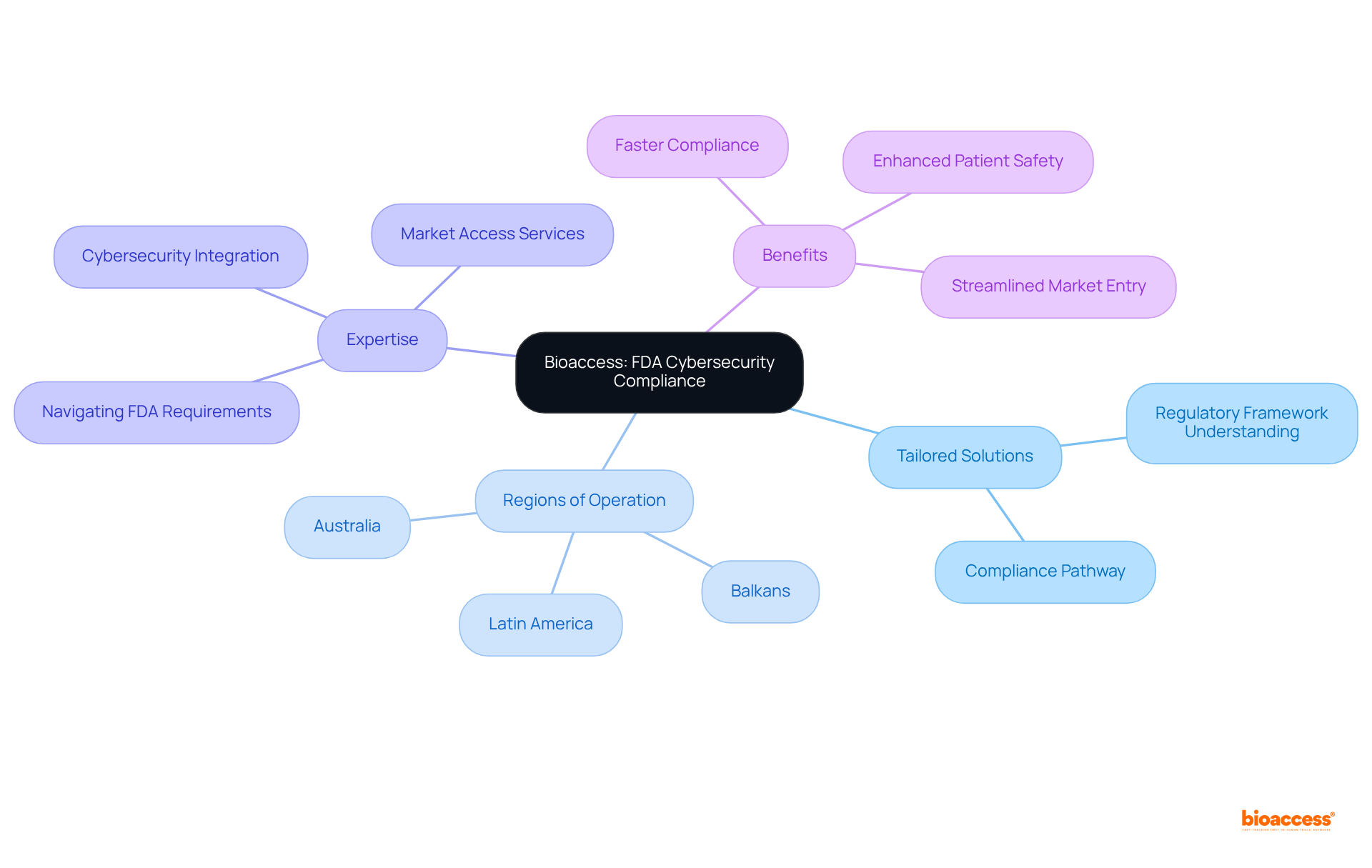
The FDA has expanded its definition of cyber products to encompass any medical equipment that incorporates software or possesses connectivity capabilities. This includes equipment capable of connecting to the internet or other networks, thereby increasing their susceptibility to security threats.
For producers, grasping this definition is crucial, as it directly influences the compliance criteria they must meet during the premarket submission process. With 92% of healthcare organizations targeted by cyberattacks in the past year, and hacking/IT incidents accounting for 80% of healthcare security breaches in 2022, the stakes are undeniably high.
Regulatory specialists emphasize that this broader definition necessitates a proactive strategy for digital security that aligns with FDA cybersecurity guidelines, as items with connectivity capabilities are particularly vulnerable to threats such as ransomware and phishing attacks. The average cost of a breach in the healthcare sector this year was $9.8 million, underscoring the financial implications of cybersecurity risks for producers and healthcare organizations.
Real-world examples illustrate this risk; for instance, the UnitedHealth cyberattack compromised the PHI of at least 100 million individuals, exposing vulnerabilities in healthcare tools that rely on cloud connectivity. Furthermore, producers must include a Software Bill of Materials (SBOM) in their premarket submissions for cybersecurity products, following the FDA cybersecurity guidelines.
As the landscape evolves, manufacturers must remain informed and adapt their strategies to ensure compliance and protect their products against emerging threats.
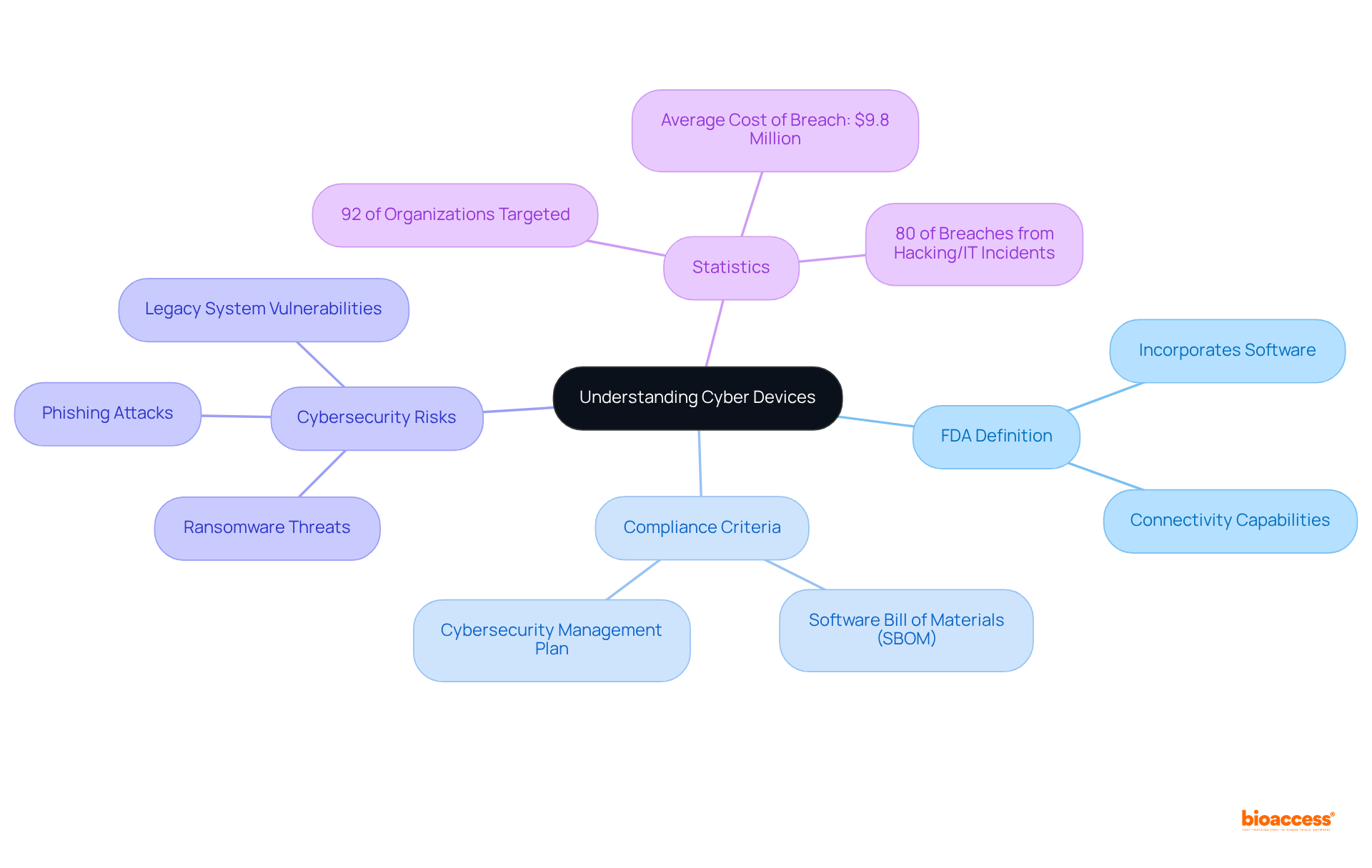
Adopting a risk-oriented strategy for premarket submissions is essential for detecting potential security threats and assessing their impact on product safety and efficacy. Manufacturers are strongly encouraged to conduct comprehensive risk assessments, meticulously documenting their findings in submissions. This proactive approach not only aligns with FDA expectations but also significantly enhances the security posture of the product throughout its lifecycle by adhering to FDA cybersecurity guidelines.
In 2023, healthcare data breaches averaged $10.93 million per incident, while the average cost of a data breach in the healthcare sector exceeded $9.77 million in 2024. These figures underscore the critical need for robust security measures in medical equipment. Furthermore, 95% of data breaches involve some form of human error, emphasizing the importance of thorough training and awareness programs for staff engaged in device development and management.
As CISA states, "Employee failure to report phishing attempts limits the organization’s ability to respond to the intrusion and alert others to the threat." By prioritizing risk evaluations related to digital security, producers can bolster protection for their products and ensure compliance with FDA cybersecurity guidelines and evolving regulatory standards.
To conduct effective risk evaluations, producers should consider:
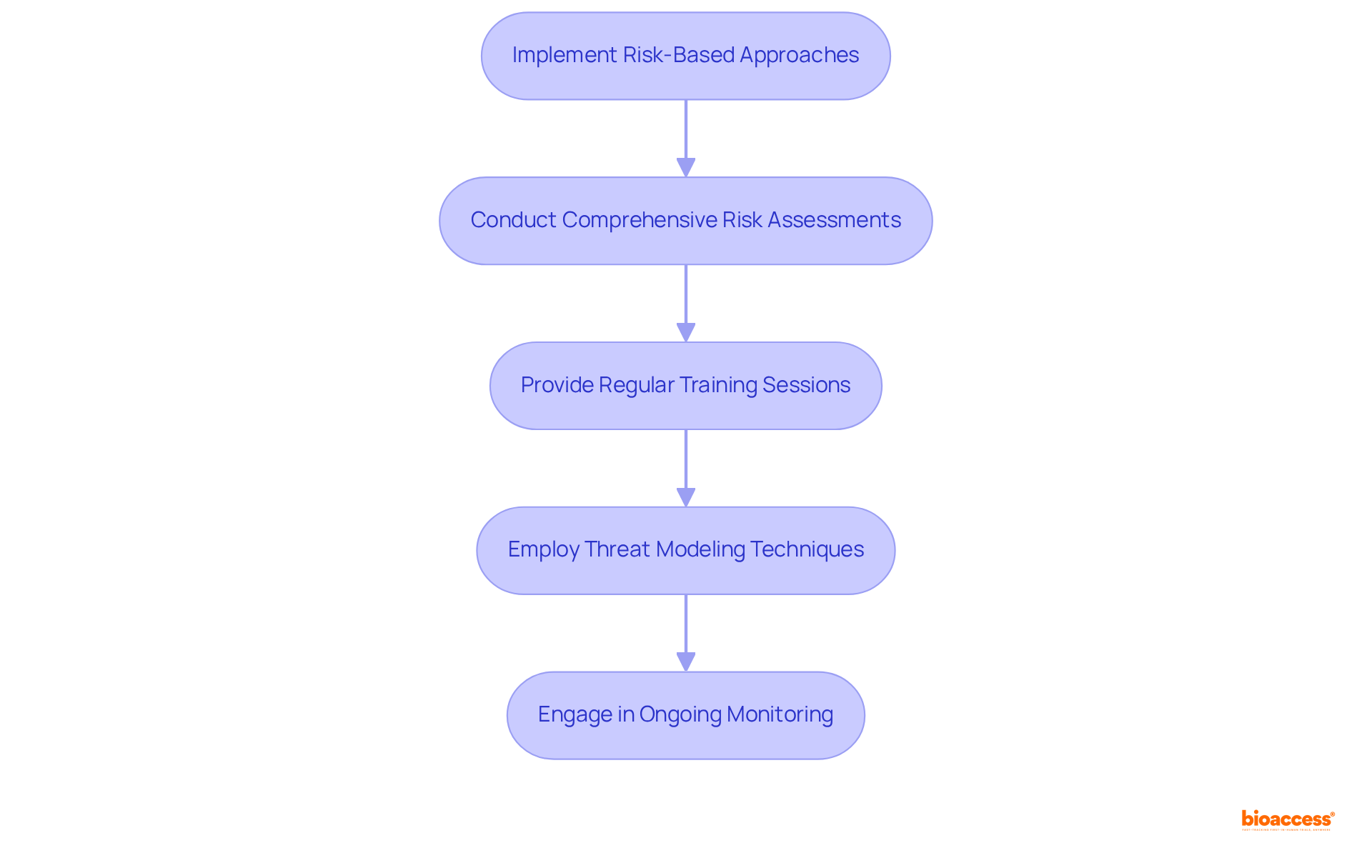
The FDA's revised guidelines highlight the critical importance of manufacturers adopting modern security standards, especially the FDA cybersecurity guidelines set by the International Organization for Standardization (ISO) and the Association for the Advancement of Medical Instrumentation (AAMI). Compliance with these standards not only streamlines the regulatory approval process but also significantly enhances the safety and reliability of medical devices. This adherence to the FDA cybersecurity guidelines is vital for safeguarding patient safety, as it ensures that equipment is designed and maintained with robust security protocols. Recent statistics indicate that companies adhering to these revised standards achieve a higher rate of successful submissions, reflecting the growing recognition of digital security as an essential component of medical equipment quality management. By embracing the FDA cybersecurity guidelines, manufacturers can effectively mitigate risks associated with cyber threats, thereby enhancing the overall integrity of their medical technologies.
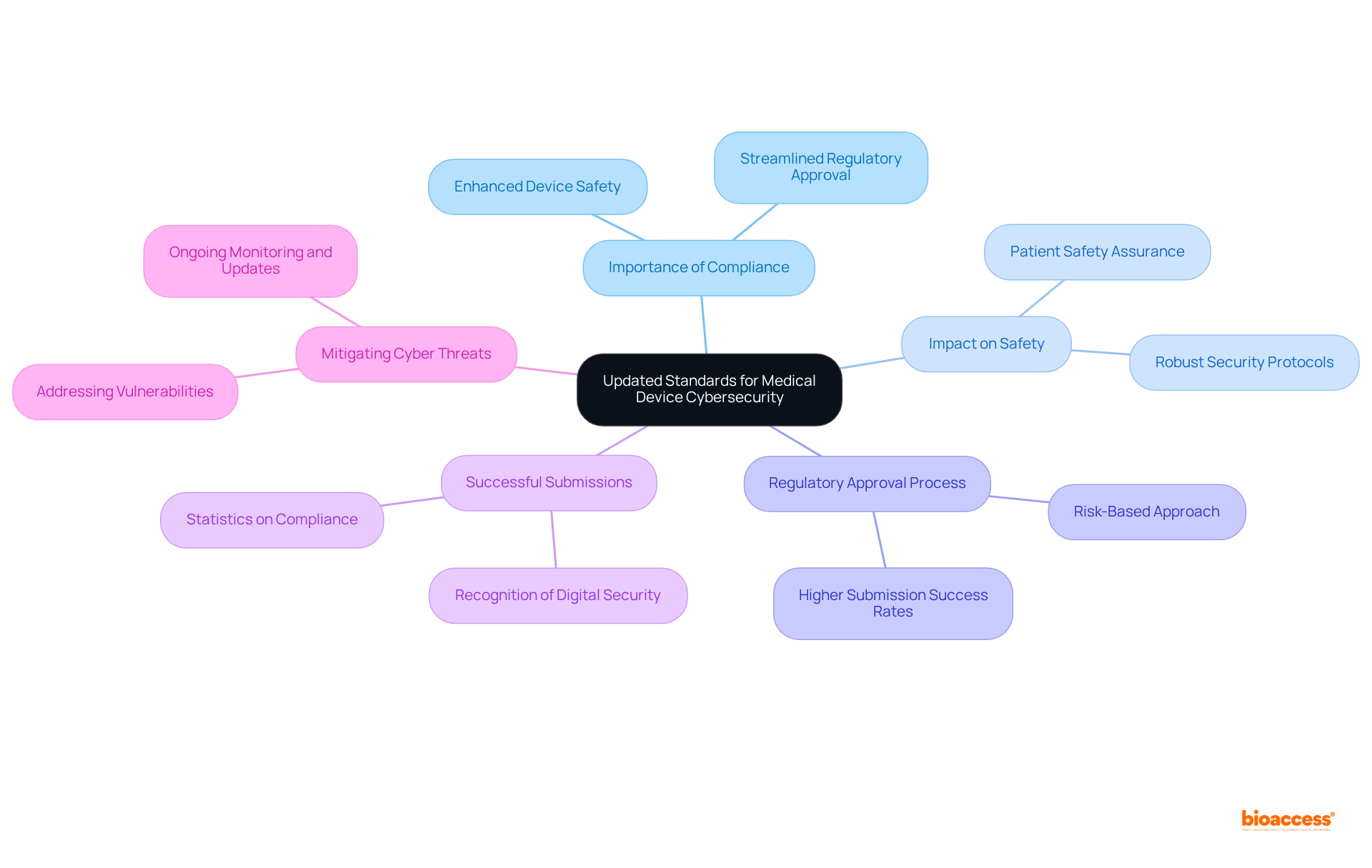
Producers are now required to adhere to the FDA cybersecurity guidelines and other stringent digital security standards, which necessitate the submission of a Software Bill of Materials (SBOM) detailing all software components utilized in their products. This documentation is crucial for compliance, offering transparency into the software supply chain and facilitating proactive identification of vulnerabilities.
Furthermore, producers must articulate their information security risk management procedures, including strategies for monitoring and addressing vulnerabilities throughout the product lifecycle. This holistic approach not only demonstrates adherence but also ensures the ongoing safety and efficacy of medical equipment in an evolving threat landscape.
Notably, recent data indicates that only a fraction of producers are fully compliant with the FDA cybersecurity guidelines, underscoring the critical need for robust documentation and risk management practices. Regulatory specialists emphasize that integrating SBOMs into submissions is vital for enhancing security and fostering trust among stakeholders in the Medtech industry.

To demonstrate adequate assurance of digital security, producers must provide extensive documentation outlining their security measures and risk management strategies. This documentation includes evidence of threat modeling, vulnerability assessments, and incident response plans. By proactively addressing potential digital security threats, manufacturers can instill confidence in the FDA and stakeholders regarding the safety and efficacy of their products.
As we approach 2025, with global cybersecurity spending projected to reach $212 billion, the significance of documented threat modeling is increasingly recognized in the Medtech sector. Cybersecurity analysts emphasize that effective risk management strategies, such as regular vulnerability assessments, are crucial for safeguarding medical devices against evolving threats.
Moreover, with an anticipated 75% rise in worldwide cyberattacks in the third quarter of 2024 compared to 2023, it is essential for producers to prioritize these proactive measures. To enhance their security posture, manufacturers should consistently evaluate and update their management plans to protect against cyber threats.
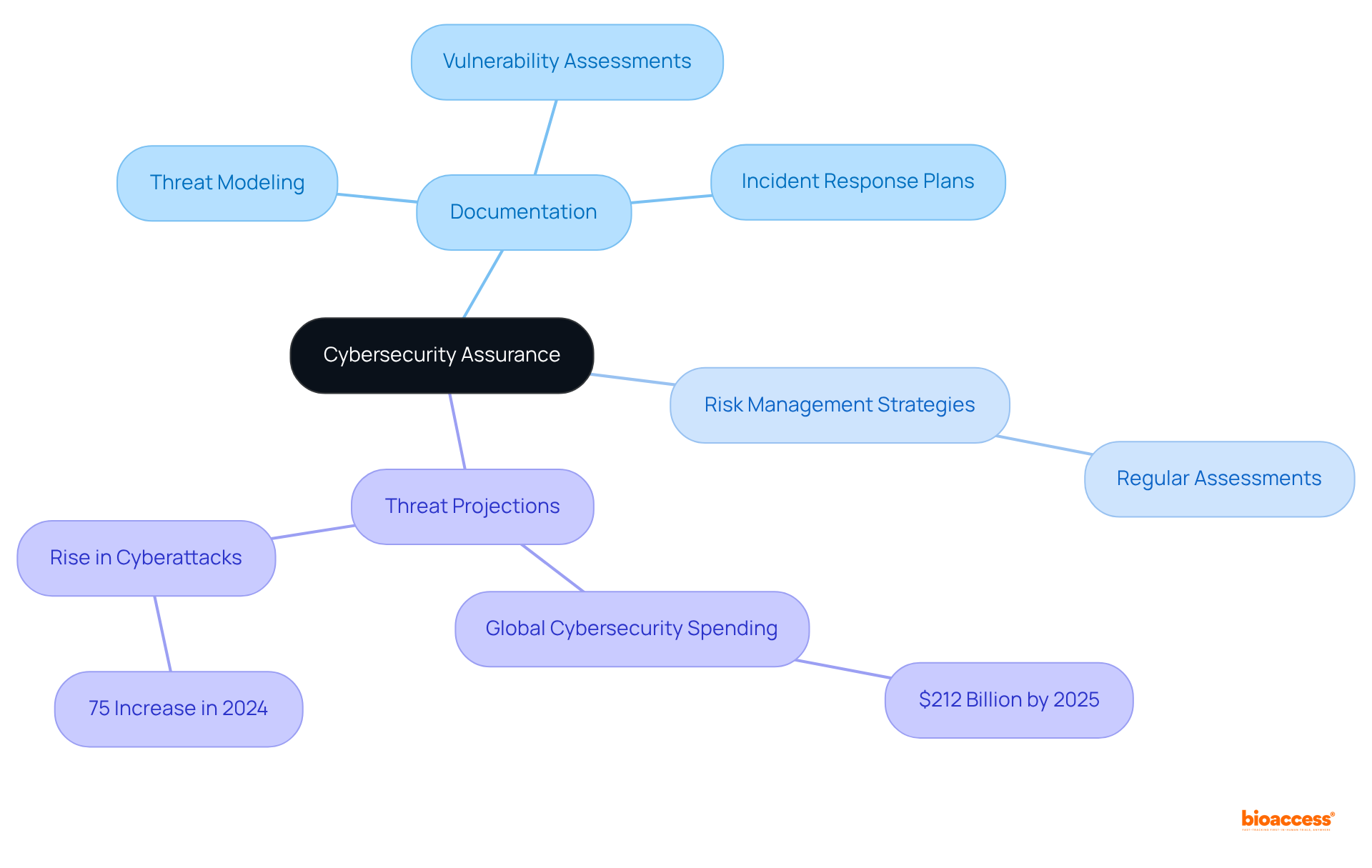
Producers must thoroughly assess any changes implemented to current medical equipment to ascertain their effect on digital security. If a modification impacts the system's security stance, a new premarket notification (510(k)) or other regulatory submissions may be necessary. It is vital to record all changes along with their possible security implications to ensure adherence to the FDA cybersecurity guidelines and maintain the device's integrity. Notably, a considerable proportion of producers are now providing new premarket notifications for alterations, indicating an increased consciousness of security threats.
Regulatory advisors stress that comprehensive documentation and proactive dialogue with the FDA are crucial for ensuring compliance, particularly when dealing with technology-related modifications. For instance, producers must present proof of how changes correspond with the FDA cybersecurity guidelines, which may involve submitting particular documents as part of the eSTAR process. This method not only protects the functionality of the equipment but also strengthens the manufacturer's dedication to patient safety and compliance with regulations.
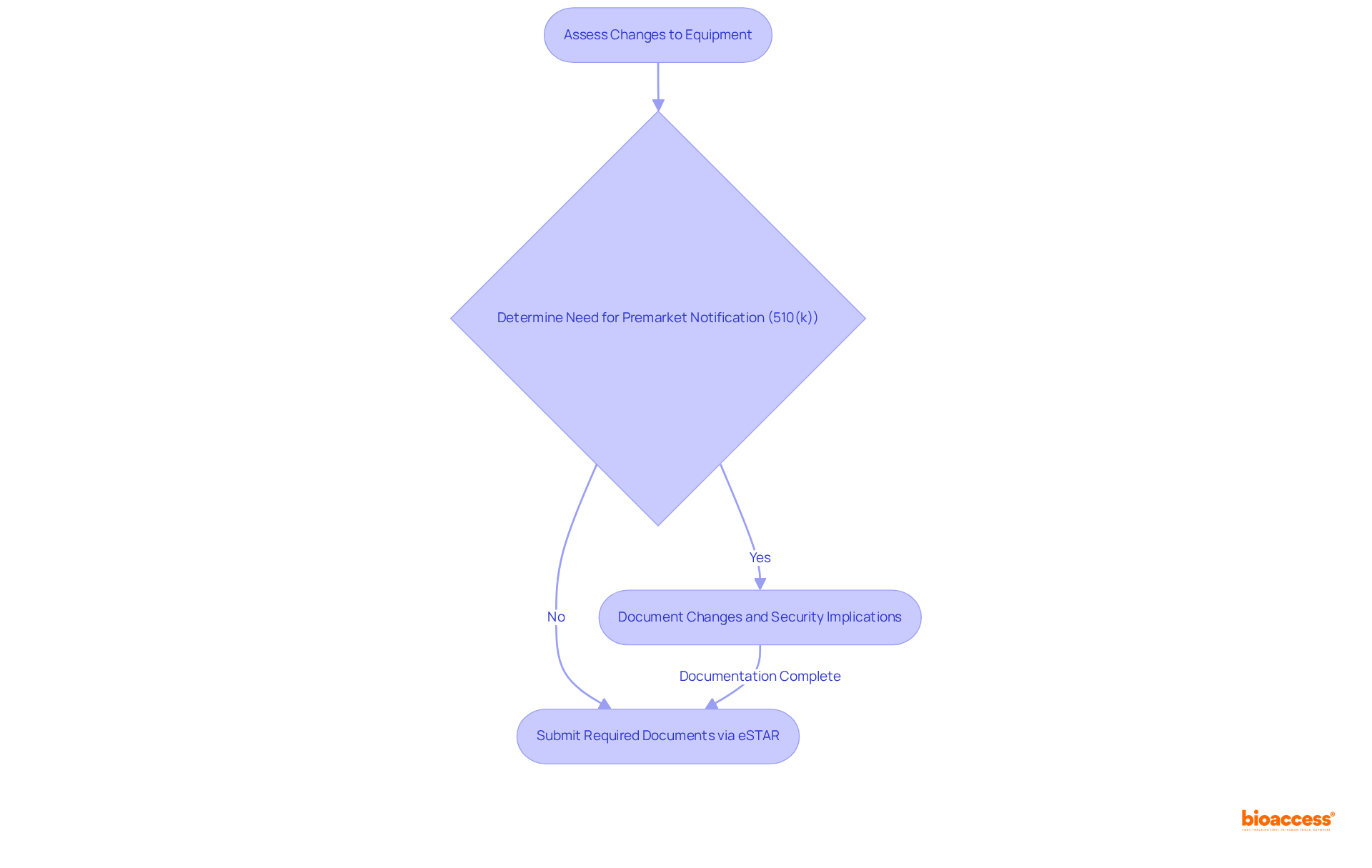
The FDA cybersecurity guidelines emphasize the critical need for integrating digital protection into the design process of medical equipment. This integration is essential for ensuring that devices remain resilient against evolving threats throughout their lifecycle. Producers are urged to conduct comprehensive risk evaluations and maintain ongoing oversight of digital security vulnerabilities. Notably, while 64% of compliance leaders prioritize enhancing the efficiency of their security programs, a mere 4% of organizations feel assured of their protection against cyberattacks. Furthermore, the discovery of 28,778 new vulnerabilities in 2023 highlights the imperative for continuous vigilance in the face of emerging threats.
Industry leaders assert that embedding cybersecurity from the outset is not just a regulatory obligation but a foundational element of product development. As one specialist articulated, 'Cybersecurity must be a fundamental aspect in the design controls of medical equipment.' This perspective aligns with the FDA cybersecurity guidelines, which are consistent with international standards and emphasize the necessity for ongoing vigilance against potential threats. Sade Sobande further elucidates that a cyber device encompasses any device containing software or being software itself, thereby expanding the scope of regulatory oversight.
Proactive strategies include:
Manufacturers are encouraged to embrace a risk-based approach, ensuring that their information security management plans are regularly updated to incorporate new insights and emerging threats. By prioritizing digital security during the design phase, Medtech companies can significantly enhance patient safety and preserve public trust in their products.
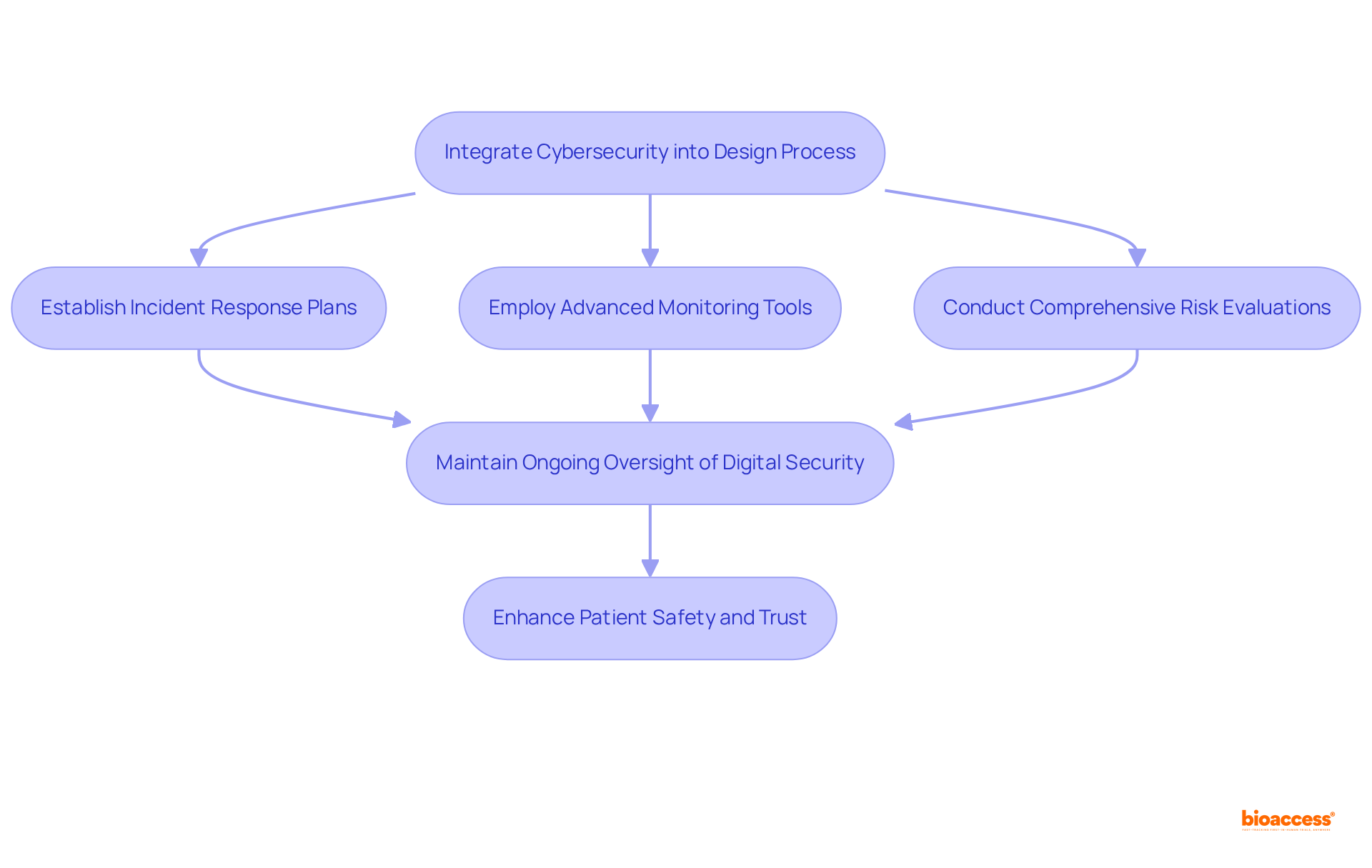
To remain at the forefront of security advancements, Medtech professionals must actively engage with a diverse array of educational resources, including webinars, training programs, and industry conferences. Organizations such as the FDA and AAMI, along with specialized security firms, provide valuable training sessions and materials that enhance understanding of best practices and regulatory compliance, particularly concerning the FDA cybersecurity guidelines.
Notably, FDA AAMI training programs specifically address security challenges while adhering to FDA cybersecurity guidelines, equipping professionals with the essential knowledge to navigate complex regulations effectively. Ongoing education is not merely advantageous; it is vital for adapting to the rapidly evolving digital security landscape, ensuring that organizations maintain compliance and security in their operations.
As Richard Clarke, former National Coordinator for Security, Infrastructure Protection, and Counter-terrorism, aptly remarked, "Spend more on coffee than on digital security?" You’re inviting a breach. This statement highlights the urgent necessity for continuous education, particularly in light of the fact that 95 percent of security breaches stem from human error.
To enhance your organization’s security posture, consider enrolling in upcoming webinars and training programs focused on the FDA cybersecurity guidelines for digital safety.
By collaborating with bioaccess, Medtech companies can leverage our extensive knowledge in navigating the FDA cybersecurity guidelines related to digital security. Our team possesses deep expertise in the latest regulatory requirements, including the necessity for a Software Bill of Materials (SBOM) and the FDA cybersecurity guidelines along with other essential security documentation. This tailored guidance guarantees that your products meet all necessary standards.
With our support, you can streamline the compliance process, reducing time to market by over 50% while enhancing the overall security of your medical devices. As one Medtech company noted, partnering with bioaccess significantly improved our compliance efficiency, allowing us to focus on innovation while effectively safeguarding our products against cybersecurity risks.
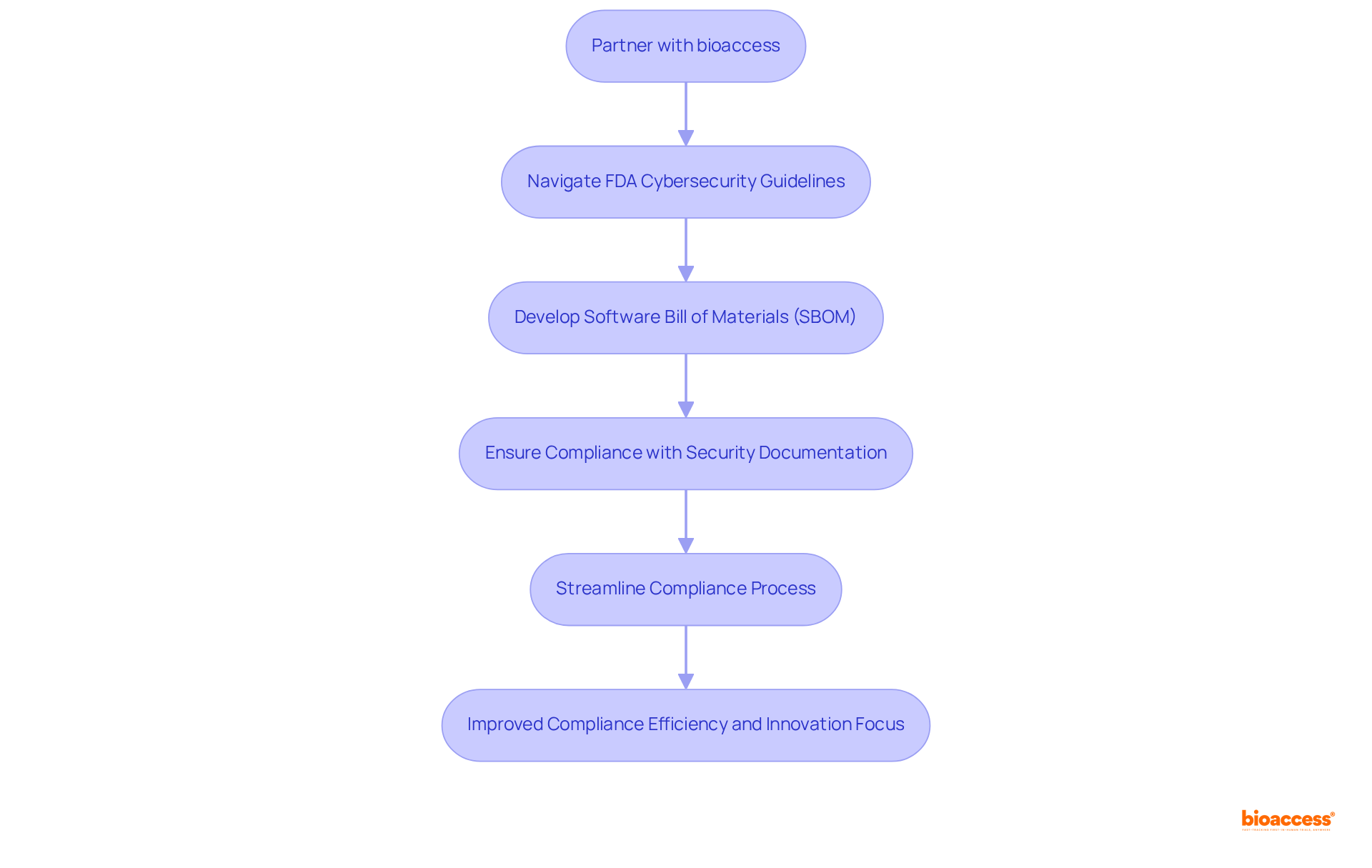
The FDA cybersecurity guidelines have emerged as a cornerstone for ensuring the safety and integrity of medical devices within an increasingly digital landscape. By emphasizing comprehensive risk assessments, updated standards, and ongoing education, these guidelines not only protect patients but also empower manufacturers to innovate with confidence. For Medtech companies, understanding and implementing these guidelines is essential to navigate the complexities of regulatory compliance while safeguarding their products against cyber threats.
Key insights throughout the article highlight:
Furthermore, the urgency for manufacturers to remain informed about evolving cybersecurity threats and to prioritize continuous education and training to mitigate risks effectively is underscored. Integrating cybersecurity into the design process and demonstrating reasonable assurance of safety is paramount for achieving compliance and fostering trust within the industry.
As the Medtech landscape continues to evolve, it is imperative for companies to embrace these guidelines not merely as regulatory obligations but as integral components of their product development strategy. By prioritizing cybersecurity from the outset, manufacturers can enhance patient safety, reduce vulnerabilities, and ultimately contribute to a more secure healthcare environment. Engaging with resources and expert guidance, such as those provided by Bioaccess, can further streamline compliance efforts and ensure that Medtech innovations are both safe and effective in the face of emerging digital threats.
What services does Bioaccess provide to Medtech firms?
Bioaccess offers tailored solutions to help Medtech firms comply with FDA cybersecurity guidelines, leveraging their understanding of regulatory frameworks to expedite the compliance process and ensure products are market-ready quickly.
How has the FDA's definition of cyber products changed?
The FDA has expanded its definition of cyber products to include any medical equipment that incorporates software or has connectivity capabilities, making them more susceptible to security threats.
Why is understanding the FDA's expanded definition of cyber products important for producers?
Understanding this definition is crucial for producers as it directly influences the compliance criteria they must meet during the premarket submission process.
What statistics highlight the importance of cybersecurity in healthcare?
In the past year, 92% of healthcare organizations were targeted by cyberattacks, with hacking/IT incidents accounting for 80% of healthcare security breaches in 2022. The average cost of a data breach in healthcare was $9.8 million in 2023.
What is a Software Bill of Materials (SBOM) and why is it important?
A Software Bill of Materials (SBOM) is a list of all software components in a product. Producers must include an SBOM in their premarket submissions for cybersecurity products as per FDA guidelines.
What approach should manufacturers take for premarket submissions regarding cybersecurity?
Manufacturers should adopt a risk-oriented strategy, conducting comprehensive risk assessments and documenting their findings to enhance product security and align with FDA expectations.
What are the average costs associated with healthcare data breaches?
In 2023, healthcare data breaches averaged $10.93 million per incident, while the average cost of a data breach in the healthcare sector exceeded $9.77 million in 2024.
What percentage of data breaches involve human error, and why is this significant?
95% of data breaches involve some form of human error, highlighting the importance of thorough training and awareness programs for staff involved in device development and management.
What strategies can producers implement to enhance digital security?
Producers can enhance digital security by instituting regular training sessions, employing threat modeling techniques, and engaging in ongoing monitoring of security threats.